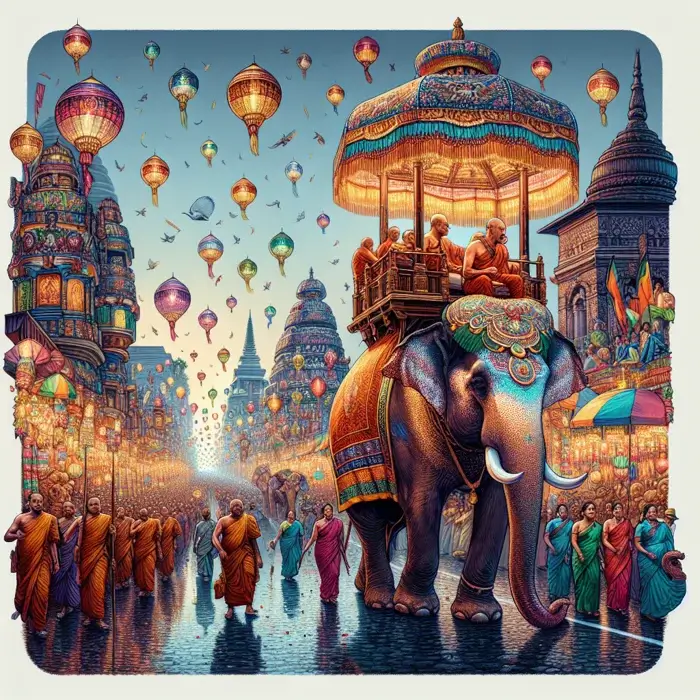Navam Full Moon Poya Day in Sri Lanka
Use our holiday API to get the exact date of Navam Full Moon Poya Day in Sri Lanka in every year.
A Recapitulation on the Navam Full Moon Poya Day

Navam Full Moon Poya Day is a prominent public holiday in Sri Lanka with a strong connection to Buddhist traditions. It occurs annually on the full moon day of February and carries immense religious and cultural significance. This occasion gives everyone food for thought about important happenings in the Buddhist history as well as a good opportunity for various people to come together as one with the intent of spiritual upliftment.
When has Navam Full Moon Poya Day Observed?
Navam Full Moon Poya Day is observed on a full moon day in the month of Navam, which falls typically in the month of February. Because of this variation from year to year, it is dependent on lunar cycles, and, thus, each needs to refer to an annual lunar calendar to find out the exact date.
Importance of Navam Full Moon Poya Day
The significance and history of Navam Full Moon Poya Day are very deep, for two major incidents from Buddhist lore are remembered on that day. First, it commemorates the appointment of the two chief disciples of the Buddha: Sariputta and Moggallana, who were instrumental in imparting the Buddha's teachings and are revered till today for their wisdom and input towards the establishment of Buddhism.
Secondly, Navam Full-Moon Poya Day marks the most historic turn in the teaching of the Buddha through his propounding of the Vinaya Pitaka, the second category of the Tipitaka, which enshrines monastic rules. The day essentially becomes a platform to reflect on the teachings of the Buddha and the very founding structures of the Buddhist monastic community.
Traditional Behaviour and Celebrations

Navam Full Moon Poya Day is celebrated by offering various forms of religious and cultural activity all over Sri Lanka. Namely, devotees come to their temples early in the day clad in white to pray and offer alms. Buddha's teaching and life are discussed and elaborated on through spiritual talks and dialogues.
Peraheras processions are also organized. These are beautiful processions featuring traditional drummers and dancers, and ornamented elephants that draw many locals and tourists to a lively vibe. Meditation facilities are included throughout the day to allow attendees to deepen their practice and reflection on the teachings of Buddha.
Another activity characteristic of Navan Poya is whereby people observe 'Dana' or giving, which stands for acts of kindness and benevolence, all very important values in Buddhism.
Public Life on Navam Full Moon Poya Day
Navam Full Moon Poya Day is also, in accordance with its importance, observed as public holiday in Sri Lanka. Schools and government offices close, as do most businesses including banks, so that everyone can take part in religious observance. Certain public transport runs on a limited schedule. However, some attractions may remain open during certain parts of the day while visitor interest varies by location, such as tourist attractions, museums, and parks.
Historical Background and Legislative Recognition

In becoming a public holiday in Sri Lanka, the full moon day of Navam marks not just the actual time of celebration but also the deep cultural orientation it has gathered over the years. Most likely the fullest-impeded practice of observing Poya full moon dates back to centuries wherein Theravada Buddhism has taken root in the island through King Devanampiya Tissa's reign in the 3rd century BCE.
Full Moon Poya days were then officially declared statutory holidays by the law promulgated post-independence to synchronize public holidays with Buddhist heritage via the law.
Conclusion
Navam Full Moon Poya Day is a replica of Buddhist traditions of Sri Lanka and cultural sentiments. It provides an occasion for the common man to ponder over the achievements and milestones that Buddhism has recorded in history while developing spiritual maturity through time-honoured practices. Navam Full Moon Poya Day immerses the devotee or curious traveler in a highly spiritual experience in Sri Lanka.
Make the best use of this rich cultural experience by visiting a temple on the day, participating in a Perahera where possible, and soaking up all the peaceful meditation and reflection one can find on this holy day.